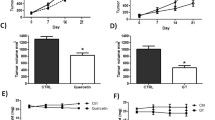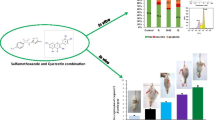Abstract
Tea polyphenols have been shown to have anticancer activity in many studies. In the present study, we investigated effects of theaflavin-3-3′-digallate (TF3), one of the major theaflavin monomers in black tea, in combination with ascorbic acid (AA), a reducing agent, and (−)-epigallocatechin-3-gallate (EGCG), the main polyphenol presented in green tea, in combination with AA on cellular viability and cell cycles of the human lung adenocarcinoma SPC-A-1 cells. The 3-(4,5-dimethylthiazol-2-yl)-2,5-diphenyl tetrazolium bromide (MTT) assay showed that the 50% inhibition concentrations (IC50) of TF3, EGCG, and AA on SPC-A-1 cells were 4.78, 4.90, and 30.62 μmol/L, respectively. The inhibitory rates of TF3 combined with AA (TF3+AA) and EGCG combined with AA (EGCG+AA) at a molar ratio of 1:6 on SPC-A-1 cells were 54.4% and 45.5%, respectively. Flow cytometry analysis showed that TF3+AA and EGCG+AA obviously increased the cell population in the G0/G1 phase of the SPC-A-1 cell cycle from 53.9% to 62.8% and 60.0%, respectively. TF3-treated cells exhibited 65.3% of the G0/G1 phase at the concentration of its IC50. Therefore, TF3+AA and EGCG+AA had synergistic inhibition effects on the proliferation of SPC-A-1 cells, and significantly held SPC-A-1 cells in G0/G1 phase. The results suggest that the combination of TF3 with AA or EGCG with AA enhances their anticancer activity.
Similar content being viewed by others
References
Agarwal, R., Mukhtar, H., 1996. Cancer chemoprevention by polyphenols in green tea and artichoke. Advances in Experimental Medicine and Biology, 401:35–50.
Chou, T.C., Talalay, P., 1984. Quantitative analysis of doseeffect relationships: the combined effects of multiple drugs or enzyme inhibitors. Advances in Enzyme Regulation, 22:27–55. [doi:10.1016/0065-2571(84)90007-4]
Chung, J.Y., Huang, C.S., Meng, X.F., Yang, C.S., 1999. Inhibition of activator protein 1 activity and cell growth by purified green tea and black tea polyphenols in H-ras-transformed cells: structure-activity relationship and mechanisms involved. Cancer Research, 59(18): 4610–4617.
Conney, A.H., Lu, Y.P., Lou, Y.R., Xie, J.P., Huang, M.T., 1999. Inhibitory effect of green and black tea on tumor growth. Proceedings of the Society for Experimental Biology and Medicine, 220(4):229–233. [doi:10.1046/j.1525-1373.1999.d01-39.x]
Denizot, F., Lang, R., 1986. Rapid colorimetric assay for cell growth and survival: modifications to the tetrazolium dye procedure giving improved sensitivity and reliability. Journal of Immunological Methods, 89(2):271–277. [doi:10.1016/0022-1759(86)90368-6]
Hatano, T., Kusuda, M., Hori, M., Shiota, S., Tsuchiya, T., Yoshida, T., 2003. Theasinensin A, a tea polyphenol formed from (−)-epigallocatechin gallate, suppresses antibiotic resistance of methicillin-resistant Staphylococcus aureus. Planta Medica, 69(11):984–989. [doi:10.1055/s-2003-45142]
Hong, J.G., Smith, T.J., Ho, C.T., August, D.A., Yang, C.S., 2001. Effects of purified green and black tea polyphenols on cyclooxygenase and lipoxygenase-dependent metabolism of arachidonic acid in human colon mucosa and colon tumor tissues. Biochemical Pharmacology, 62(9): 1175–1183. [doi:10.1016/S0006-2952(01)00767-5]
Kaack, K., Austed, T., 1998. Interaction of vitamin C and flavonoids in elderberry (Sambucus nigra L.) during juice processing. Plant Foods for Human Nutrition, 52(3): 187–198. [doi:10.1023/A:1008069422202]
Kim, K.N., Pie, J.E., Park, J.H., Park, Y.H., Kim, H.W., Kim, M.K., 2006. Retinoic acid and ascorbic acid act synergistically in inhibition human breast cancer cell proliferation. The Journal of Nutritional Biochemistry, 17(7): 454–462. [doi:10.1016/j.jnutbio.2005.10.009]
Leung, L.K., Su, Y., Chen, R., Zhang, Z., Huang, Y., Chen, Z.Y., 2001. Theaflavins in black tea and catechins in green tea are equally effective antioxidants. Journal of Nutrition, 131(9):2248–2251.
Lu, J.B., Ho, C.T., Ghai, G., Chen, K.Y., 2000. Differential effects of theaflavin monogallates on cell growth, apoptosis, and Cox-2 gene expression in cancerous versus normal cells. Cancer Research, 60(22):6465–6471.
Lung, H.L., Ip, W.K., Chen, Z.Y., Mak, N.K., Leung, K.N., 2004. Comparative study of the growth-inhibitory and apoptosis-inducing activities of black tea theaflavins and green tea catechin on murine myeloid leukemia cells. International Journal of Molecular Medicine, 13(3): 465–471.
Mittal, A., Pate, M.S., Wylie, R.C., Tollefsbol, T.O., Katiyar, S.K., 2004. EGCG down-regulates telomerase in human breast carcinoma MCF-7 cells, leading to suppression of cell viability and induction of apoptosis. International Journal of Oncology, 24(3):703–710.
Moon, Y., Lee, M., Yang, H., 2007. Involvement of early growth response gene 1 in the modulation of microsomal prostaglandin E synthase 1 by epigallocatechin gallate in A549 human pulmonary epithelial cells. Biochemical Pharmacology, 73(1):125–135. [doi:10.1016/j.bcp.2006.08.017]
Mosmann, T., 1983. Rapid colorimetric assay for cellular growth and survival: application to proliferation and cytotoxicity assays. Journal of Immunological Methods, 65(1–2):55–63. [doi:10.1016/0022-1759(83)90303-4]
Pan, M.H., Lin-Shiau, S.Y., Ho, C.T., Lin, J.H., Lin, J.K., 2000. Suppression of lipopolysaccharide-induced nuclear factor-kappa B activity by theaflavin-3,3′-digallate from black tea and other polyphenols through down-regulation of I kappa B kinase activity in macrophages. Biochemical Pharmacology, 59(4):357–367. [doi:10.1016/S0006-2952(99)00335-4]
Roomi, M.W., Ivanov, V., Kalinovsky, T., Niedzwiecki, A., Rath, M., 2006. Inhibition of matrix metalloproteinase-2 secretion and invasion by human ovarian cancer cell line SK-OV-3 with lysine, proline, arginine, ascorbic acid and green tea extract. Journal of Obstetrics and Gynaecology Research, 32(2):148–154. [doi:10.1111/j.1447-0756.2006.00389.x]
Saeki, K., Sano, M., Miyase, T., Nakamura, Y., Hara, Y., Aoyagi, Y., Isemura, M., 1999. Apoptosis-inducing activity of polyphenol compounds derived from tea catechins in human histiolytic lymphoma U937 cells. Bioscience Biotechnology and Biochemistry, 63(3):585–587. [doi:10.1271/bbb.63.585]
Tu, Y.Y., Xia, H.L., 2004. Immobilized Polyphenol Oxidase Catalyze Purified Tea Polyphenols into High Quality Theaflavins. China Patent 02136982.8 ZL.
Tu, Y.Y., Tang, A.B., Watanabe, N., 2004. The theaflavin monomers inhibit the cancer cells growth in vitro. Acta Biochimica et Biophysica Sinica, 36(7):508–512. [doi:10.1093/abbs/36.7.508]
Weisburg, J.H., Weissman, D.B., Sedaghat, T., Babich, H., 2004. In vitro cytotoxicity of epigallocatechin gallate and tea extracts to cancerous and normal cells from the human oral cavity. Basic & Clinical Pharmacology & Toxicology, 95(4):191–200.
Yang, C.S., Lambert, J.D., Ju, J., Lu, G., Sang, S., 2007. Tea and cancer prevention: molecular mechanisms and human relevance. Toxicology and Applied Pharmacology, 224(3): 265–273. [doi:10.1016/j.taap.2006.11.024]
Yang, C.S., Wang, X., Lu, G., Picinich, S.C., 2009. Cancer prevention by tea: animal studies, molecular mechanisms and human relevance. Nature Reviews Cancer, 9(6):429–439. [doi:10.1038/nrc2641]
Yang, G.Y., Liao, J., Kim, K., Yurkow, E.J., Yang, C.S., 1998. Inhibition of growth and induction of apoptosis in human cancer cell lines by tea polyphenols. Carcinogenesis, 19(4):611–616. [doi:10.1093/carcin/19.4.611]
Yang, Z., Jie, G., Dong, F., Xu, Y., Watanabe, N., Tu, Y., 2008. Radical-scavenging abilities and antioxidant properties of theaflavins and their gallate esters in H2O2-mediated oxidative damage system in the HPF-1 cells. Toxicology in Vitro, 22(5):1250–1256. [doi:10.1016/j.tiv.2008.04.007]
Yang, Z.Y., Tu, Y.Y., Xia, H.L., Jie, G.L., Chen, X.M., He, P.M., 2007. Suppression of free-radicals and protection against H2O2-induced oxidative damage in HPF-1 cell by oxidized phenolic compounds present in black tea. Food Chemistry, 105(4):1349–1356. [doi:10.1016/j.foodchem.2007.05.006]
Zheng, Q.S., Zhang, Y.T., Zheng, R.L., 2002. Ascorbic acid induces redifferentiation and growth inhibition in human hepatoma cells by increasing endogenous hydrogen peroxide. Pharimazie, 57(11):753–757.
Author information
Authors and Affiliations
Corresponding author
Additional information
Project supported by the Key Program of Science and Technology of Zhejiang Province (No. 2007C12068) of China and the National Natural Science Foundation of China (No. 30901002)
Rights and permissions
About this article
Cite this article
Li, W., Wu, Jx. & Tu, Yy. Synergistic effects of tea polyphenols and ascorbic acid on human lung adenocarcinoma SPC-A-1 cells. J. Zhejiang Univ. Sci. B 11, 458–464 (2010). https://doi.org/10.1631/jzus.B0900355
Received:
Accepted:
Published:
Issue Date:
DOI: https://doi.org/10.1631/jzus.B0900355
Key words
- Theaflavin-3-3′-digallate (TF3)
- (−)-epigallocatechin-3-gallate (EGCG)
- Ascorbic acid (AA)
- Synergism
- SPC-A-1 cells
- Cell cycle




